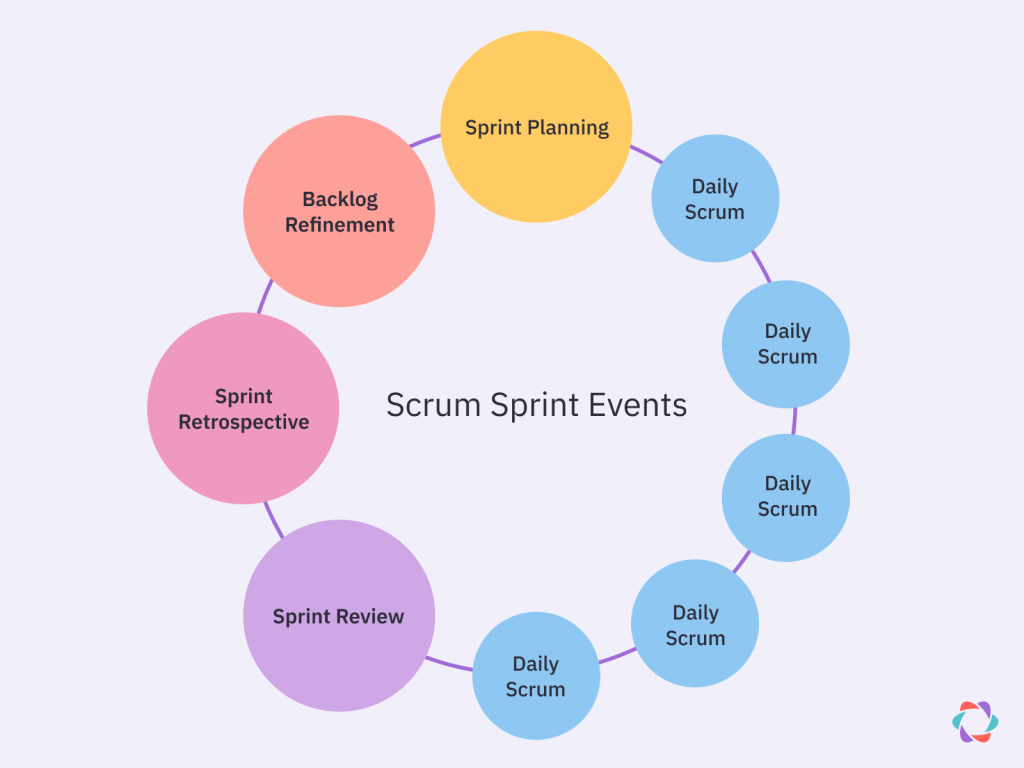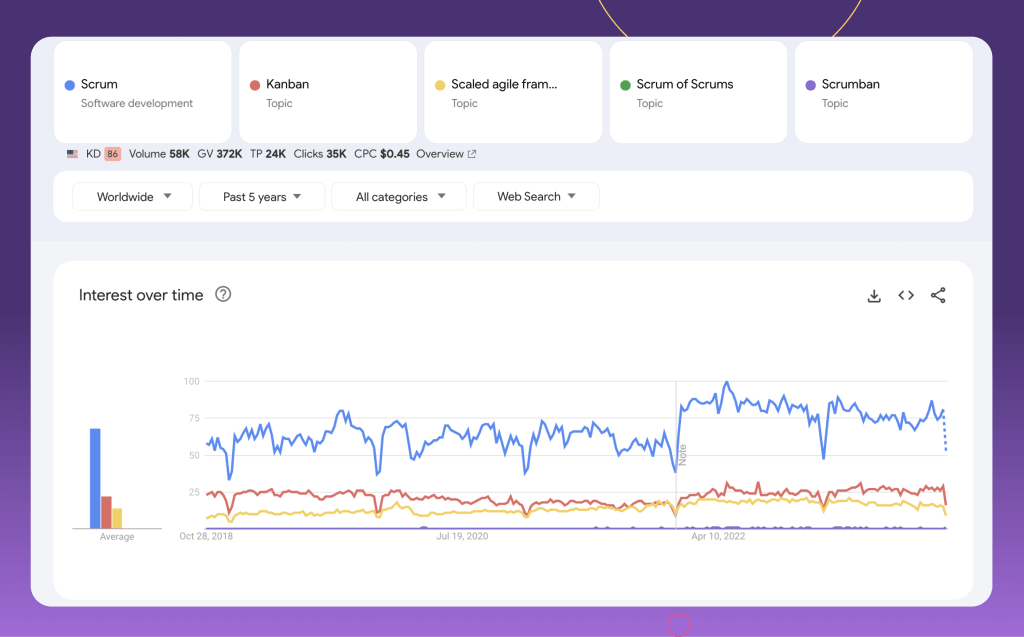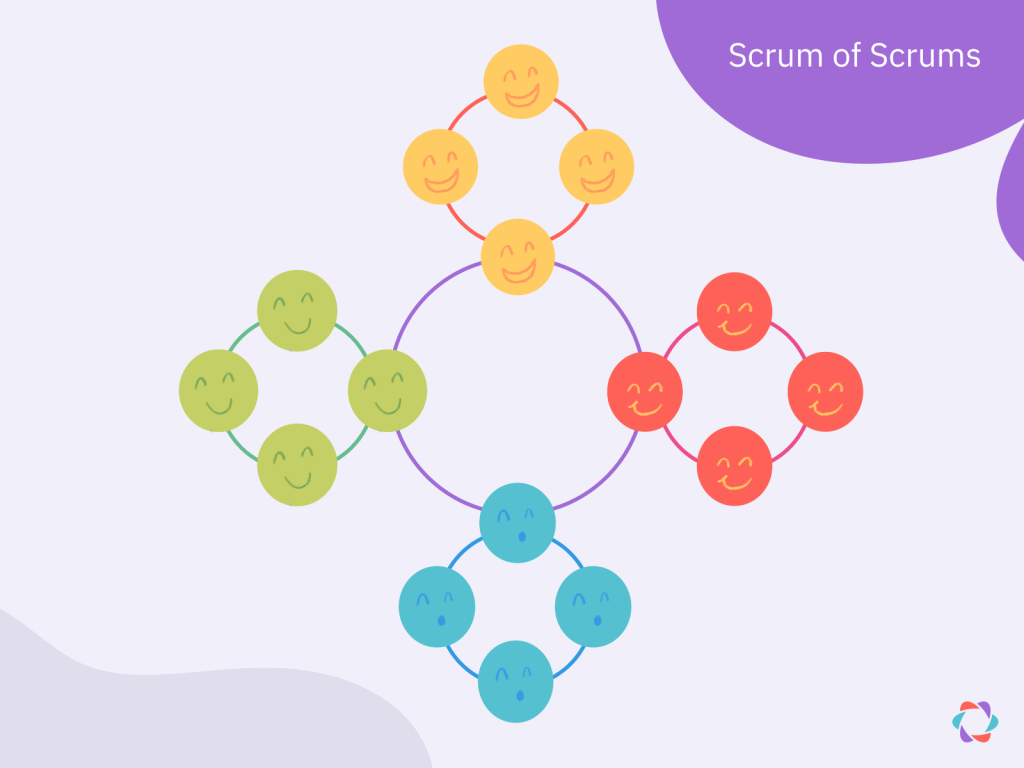What Are The Most Popular Agile Methodologies in 2024?

Whether you’re researching the latest in software development or making a case for investing in Agile work practices, it helps to know where the fast-moving Agile community currently is.
That’s why we’ve created this list of the most popular Agile methodologies of 2023. The rankings in this article are based on the most recent State of Agile Report and compiled statistics from around the web. So, instead of scouring multiple opinion pieces or years-old data, this list allows you to jump in and understand what’s popular right now in the Agile community.
The top agile methodologies in 2023 are:
- Scrum
- Kanban
- Scaled Agile Framework (SAFe)
- Scrum of Scrums
- Scrumban
1. Scrum
Scrum is currently the most popular Agile methodology, with 87% of respondents reporting they were using Scrum in their business.

Here are a few statistics explaining why teams are consistently choosing Scrum over the alternatives:
- Teams that engaged in full Scrum processes showed better quality than teams that did no estimating to the tune of about 250%. (Source: CA Technologies)
- Teams that employ retrospectives (a key part of Scrum) improved quality by 42% and responsiveness by 24%. (Source: CA Technologies)
- 85% of Scrum practitioners said adopting Scrum helped improve the quality of their work life. (Source: Scrum Alliance)
Google Trends confirms this popularity as it is by far the most searched-for Agile methodology on this list.

A quick recap of Scrum: Scrum is a loose framework that helps teams deliver customer value and iterate on products faster than traditional project management approaches. It is based on a broad set of rules and guidelines that help teams work effectively in sprints. Each sprint is fairly short (between 1 and 4 weeks) and focuses on a specific sprint goal. The end goal of each sprint is to deliver a small increment of working software that contributes to a better end product for customers.
See more statistics about Scrum in the Scrum section of our Agile statistics report, and learn more about Scrum itself in our Complete Guide to Getting Started With Scrum.
2. Kanban
Kanban is the second most popular Agile methodology right now, with a reported 56% of people employing it in their teams. Kanban is an arguably simpler approach to agile working that has gained popular acclaim due to “kanban boards” becoming more mainstream.

Here are some statistics showing why Kanban has earned itself this following:
- 87% of those surveyed in a Kanban-centric report believe Kanban outperforms other Agile methods in terms of effectiveness. (Source: State of Kanban Report 2022)
- Research exploring the differences between Scrum and Kanban found that while both lead to better software development outcomes, Kanban had the edge when it came to helping teams with scheduling, i.e., knowing what the status of a project was and delivering it on time. (Source: A statistical analysis of the effects of Scrum and Kanban on software development projects)
- 86% of respondents said they planned on increasing their Kanban usage in the coming year. (Source: State of Kanban Report 2022)
- One study that synthesized results from several different research papers found that the top benefits of Kanban were improvements to “work visibility,” “flow of work,” “control of project activities and tasks,” and “time-to-market.” (Source: On the benefits and challenges of using kanban in software engineering: a structured synthesis study)
Part of Kanban’s charm is the simplicity of its namesake board. With a few defined columns and some workflow automation, teams can get production flowing as everyone sees what tasks are in progress, who is working on them, and what’s next in the queue.
However, Kanban is about more than just the board. It’s a philosophy that emphasizes the importance of work flowing smoothly without bottlenecks or interruptions. This focus on continuous flow and adaptability makes Kanban ideal for cyclical or ongoing work, allowing teams to consistently move tasks from backlog to work in progress to completion.
Explore more about Kanban in our article on Scrum vs. Kanban and in the State of Kanban Report 2022.
3. Scaled-Agile Framework (SAFe)
Rounding out the top three most popular Agile methodologies is SAFe. In the 16th State of Agile Report, 53% of respondents said they used SAFe practices within their organization. Many consider SAFe to be the enfant terrible of the Agile world, with it dividing opinion between lovers and haters.
To see why so many people choose SAFe, here are a couple of case studies demonstrating how effective it can be:
- AirFrance found that teams following the SAFe framework achieved a 20% higher release effectiveness compared to waterfall teams. (Source: Scaled Agile)
- The Centers for Medicare and Medicaid Services reallocated their budget so there was room for more innovation through the use of SAFe. As a result, help desk tickets decreased by 55%, and surveys indicated a 27% increase in employee satisfaction. (Source: Scaled Agile)
- According to one study that surveyed 100 industry participants, the top benefits of SAFe include improvements to collaboration between teams (71% agree or strongly agree), dependency management between teams (68% agree or strongly agree), and transparency (66% agree or strongly agree). (Source: Benefits and Challenges of Adopting SAFe – An Empirical Survey)
Unlike Scrum and Kanban, which are more team-focused, SAFe attempts to scale Agile approaches to make them work at an organizational level. This differentiator makes SAFe attractive for many because larger companies want the benefits of Agile, but 44% of them find it difficult when scaling beyond the team level.
However, despite its benefits, SAFe is not without controversy. Many agile coaches feel SAFe is too prescriptive, sacrificing speed and nimbleness at the team level for more control by management.
For some, this is a trade-off worth making, while for others, SAFe misses the whole point of Agile in the first place.
4. Scrum of Scrums
Scrum of Scrums is the fourth most popular Agile methodology and the second most popular for scaling up Agile for larger teams and organizations. In the most recent State of Agile report, 28% of respondents said they used Scrum of Scrums.

Here are just a few case studies proving why Scrum of Scrums is so popular:
- Dell’s switch to the Scrum of Scrums methodology helped them achieve a perfect 100% on-time release record and a 94% drop in known bugs on releases. (Source: Scrum@Scale)
- Bosch’s agricultural division achieved the rapid development and delivery of 10 new systems within four weeks through the implementation of Scrum of Scrums. Previously, they averaged one every six to eight months. (Source: Scrum@Scale)
- Safety Co. implemented Scrum of Scrums and saw a 40% increase in customer on-time delivery performance and a 24% increase in ROI from active projects. (Source: Scrum Inc)
Like SAFe, Scrum of Scrums is a solution that allows larger teams to get the advantages of Agile without sacrificing higher-level planning and control. However, Scrum of Scrums really shines as a middle ground as teams continue their regular Scrum practices while also adding a Scrum of Scrums meeting where representatives from each Scrum meet and coordinate. This way, each team can better understand what’s happening on a company-wide level and plan accordingly.
This flexibility makes Scrum of Scrums incredibly attractive to businesses who want to retain small Scrum team independence while ensuring a growing team stays aligned with company goals.
5. Scrumban
The final methodology on our list is Scrumban, with around 27% of respondents saying they use this framework.

As its name suggests, Scrumban combines the more popular Scrum and Kanban methodologies. There are no formal Scrumban rules. Teams can pick and choose any parts of these two methodologies that work for them.
Typically, Scrumban works best for teams transitioning from either Scrum to Kanban or vice versa. However, many people stick with this hybrid solution, finding this mix-and-match approach best suits their unique circumstances.
If you’re interested in trying out this flexible approach to Agile, check out our Scrumban guide.
📌 Get more Agile statistics and data
Are you interested in learning more about the benefits of Agile? We’ve compiled a list of 300+ Agile statistics broken down by topics like methodology, trends, department usage, and much more.
With this free, explorable database, you can answer nearly any question you have about Agile. So whether you’re learning about Agile, researching a specific methodology, or trying to get buy-in from your team, this is the place on the web to find the hard facts you need.









